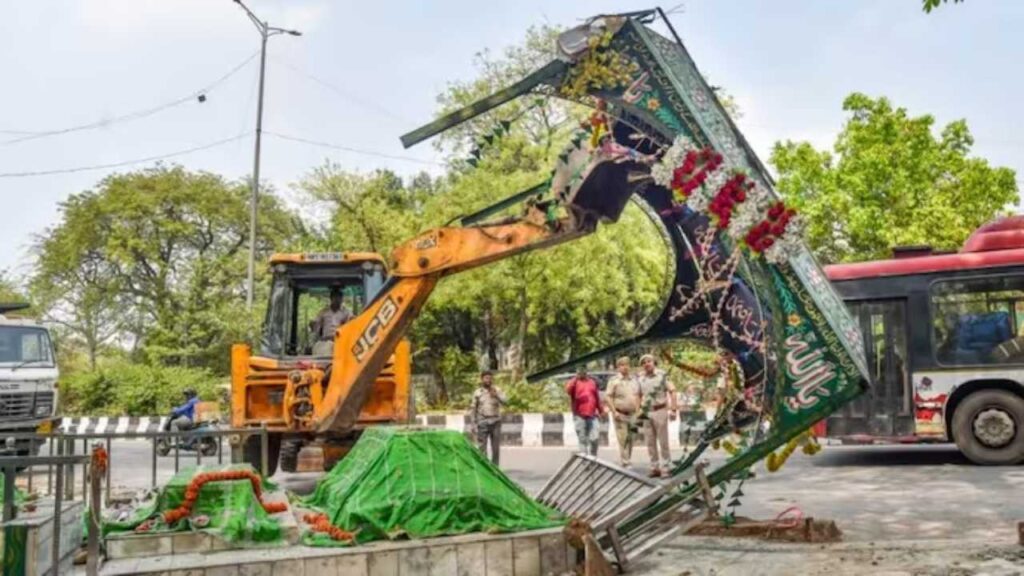The Delhi High Court ordered the Central Bureau of Investigation (CBI) on Tuesday to look into illegal construction at a sealed guest house that is just 100 meters from the nationally recognized monument Nizamuddin ki Baoli. The court stated that it is unprecedented how much unauthorized construction is occurring in the capital despite the existence of numerous local authorities and a complex system of checks and balances.
In Nizamuddin ki Baoli and Barakhamba Tomb [Jamia Arabia Nizamia Welfare Education Society v. Delhi Development Authority through its Vice Chairman and Ors], Chief Justice Manmohan and Justice Manmeet Pritam Singh Arora, who sit on the bench, expressed dismay that the police were unable to put an end to the action that was taking place in the middle of the city.
“In the center of the city, an illegal behemoth the size of a five-story structure has emerged. Unprecedented levels of illegal development are occurring in Delhi despite a complex system of checks and balances and many agencies, according to the Bench.

The bench, presided over by acting Chief Justice Manmohan, ordered the authorities to come up with fresh approaches to address the problem, comparing encroachment to dacoity because the public loses its assets and the land-owning agency loses its land in the process.
“It makes sense why the demolition and sealing efforts are failing. In order to combat the threat of encroachment and unlawful construction, this court orders the MCD commissioner and the vice chairman of the DDA to implement structural changes and create new plans,” the court noted.
“The executive appears content with the current state of affairs and is not inclined to change the system through the use of readily available technology, such as drones and other techniques. Today, MCD still seals buildings with tape and rope and typically punctures the roofs partially in the process of demolishing a structure. It makes sense that the sealing and demolition actions are ineffective,” the Bench noted in its ruling that in order to address the issue of unauthorized construction, the court noted that fundamental improvements are necessary in the respondents’ operation.
The Court observed that even though the Delhi Police has filed a FIR, it would be appropriate to forward it to the CBI so that it can conduct a thorough investigation.
In the course of hearing a public interest litigation (PIL) brought by Jamia Arabia Nizamia Welfare Education Society, the Court issued a judgment ordering an investigation into the actions of DDA and Archaeological Survey of India (ASI) officials.
The development was only a few yards away from ASI-protected structures, according to the plea.
“Despite so many statutory authorities having been created, how could it be that the construction was completed? This court is of the view that even if there is a dispute regarding ownership of the land, it is not understood as to how the property has changed hands, as to how the nature of the property has changed, or as to how fresh construction has been carried out. From the documents on record, it is not clear as to how the property from a graveyard to a single-room godown became a single-story and five-story building. No documents have been placed on record,” the court noted.
The MCD informed the court that the guest house, which is purportedly illegal, is located on DDA property. However, the DDA countered that the MCD had a duty to control the area’s construction bylaws, enforce them, and remove any illegal encroachments.
As a result, it gave the MCD Commissioner and the DDA Vice-Chairman (VC) instructions to implement structural changes and come up with fresh strategies for handling encroachment and unauthorized development in the city.
It has been mandated that the VC and Commissioner have a meeting to discuss the matter and present the meeting minutes to the court.
In the meantime, the Delhi Waqf Board asserted that they are the owners of the land where the property is located. The DDA was against this. The Bench conveyed surprise at these claims and stated that it is unclear how the property’s usage evolved from a single-story warehouse to a five-story building, then back to a graveyard.









